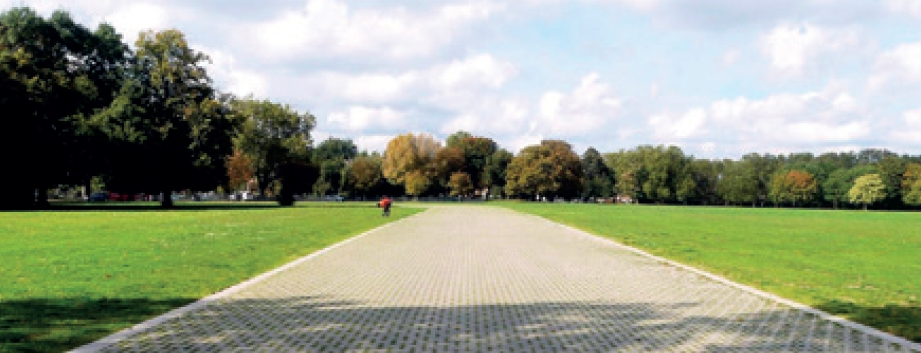Green infrastructure
Contents |
[edit] Introduction
Green infrastructure is defined as, ‘...a network comprising the broadest range of high quality green spaces and other environmental features ...it needs to be delivered at all spatial scales from sub-regional to local neighbourhood level.’ (ref. Natural England, 2009)
The National Planning Policy Framework (NPPF), defines green infrastructure as: ‘A network of multi-functional green and blue spaces and other natural features, urban and rural, which is capable of delivering a wide range of environmental, economic, health and wellbeing benefits for nature, climate, local and wider communities and prosperity’.
Green infrastructure can include:
- Parks.
- Playing fields.
- Woodlands.
- Village greens.
- Residential gardens.
- Woodlands.
- Trees along roads.
- Allotments.
- River systems and coastal environments (which can also be known as 'blue infrastructure').
In the rural environment, green infrastructure is considered to be the larger landscape features, such as; river corridors, flood meadows, wide green corridors and ecological networks (ref Natural England, 2009).
NB: Planning practice guidance defines green infrastructure as:
'...a network of multifunctional green space, urban and rural, which is capable of delivering a wide range of environmental and quality of life benefits for local communities. Green infrastructure is not simply an alternative description for conventional open space. As a network it includes parks, open spaces, playing fields, woodlands, but also street trees, allotments and private gardens. It can also include streams, canals and other water bodies and features such as green roofs and walls.'
Home Quality Mark One, Technical Manual SD239, England, Scotland & Wales, published by BRE in 2018, defines green infrastructure as:
'Multi-functional space, urban and rural, that can form a network or be self-contained, which is capable of delivering a wide range of environmental and quality of life benefits for local communities. It covers both ‘green’ and ‘blue’ (water environment) features of the natural and built environments. Examples include parks, open spaces, playing fields, woodlands, wetlands, grasslands, river and canal corridors, allotments, private gardens and living (green) roofs and façades.'
The SuDS Manual, 2015, defines green infrastructure as ‘…strategically planned and interconnected networks of natural and manmade green spaces (including blue space) or corridors that deliver a function for the local community.’
[edit] Benefits of green infrastructure
If green infrastructure is well planned, with a shared understanding of the aims between developers, planners and ecologists, then wide-ranging benefits can be delivered, including:
- Reduced flood risk.
- Increased property and land values.
- Safeguarding and enhancing natural and historic assets.
- Reversal of habitat fragmentation.
- An increase in biodiversity to restore functioning ecosystems and provide the basis for sustainable development.
- Enhanced landscape character.
- A focus for health and well-being, education and training.
- Reduced pollution.
[edit] Planning
All development proposals should consider opportunities to enhance biodiversity and contribute to habitat connectivity in the wider area. The National Planning Policy Framework (NPPF) places an emphasis on sustainable development which includes net gains for nature, and a key principle for planning is the conservation and enhancement of the natural environment and a reduction in pollution.
[edit] Green Infrastructure Partnership
The Green Infrastructure Partnership was established in 2011 following publication of the government’s Natural Environment White Paper. It supports the development of green infrastructure by helping identify and improve green infrastructure’s benefits as an ecological network for health, well-being and climate change buffering. Regular newsletters are published by the partnership summarising the latest news, policy and other developments related to green infrastructure.
[edit] The London Plan
The London Plan, Published by the Mayor of London in March 2016, suggests that green infrastructure refers to: ‘The multifunctional, interdependent network of open and green spaces and green features (e.g. green roofs). It includes the Blue Ribbon Network but excludes the hard-surfaced public realm. This network lies within the urban environment and the urban fringe, connecting to the surrounding countryside. It provides multiple benefits for people and wildlife including: flood management; urban cooling; improving physical and mental health; green transport links (walking and cycling routes); ecological connectivity; and food growing. Green and open spaces of all sizes can be part of green infrastructure provided they contribute to the functioning of the network as a whole.’
[edit] Related articles on Designing Buildings
- Benefits, not cost, should be focus of key infrastructure projects
- Better infrastructure will lead us to a better future.
- Biodiversity.
- Blue infrastructure.
- Blue-green infrastructure.
- Campaigning for biodiversity.
- Ecosystem.
- Ecology connectivity.
- Future finance - paying for infrastructure after Brexit.
- Green belt.
- Green bridge.
- Green chain.
- Green grid.
- Green network.
- Green plot ratio.
- Green roof.
- Green space.
- Green tunnel.
- Green walls.
- Greenway.
- Growing space.
- Habitat.
- Helping to make Europe a wilder place.
- How green infrastructure is helping to control urban floods.
- Infrastructure carbon reduction misses net-zero target.
- Living Roofs and Walls, from policy to practice.
- Long term, strategic approaches to infrastructure planning.
- Natural capital.
- New deal for infrastructure 2020.
- Parleys Canyon Wildlife Bridge.
- Resilience of UK infrastructure and climate predictions.
- The future of green infrastructure.
[edit] External references
Surrey Hills Directory
[edit] Planning
Building Design in the Surrey Hills
[edit] Highways
Conserving and Enhancing Country Lanes in the Surrey Hills AONB
[edit] Biodiversity & Landscape
Landscapes Review: National Parks & AONBs 2019
Light Pollution - Threat to Migrating Birds
Making Local Nature Recovery Strategies deliver
[edit] Health & Wellbeing
Nature and Wellbeing: The Evidence
How nature can be used to improve wellbeing







